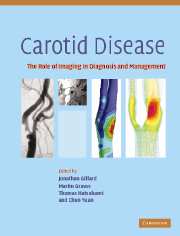Crossref Citations
This Book has been
cited by the following publications. This list is generated based on data provided by Crossref.
Tang, Dalin
Yang, Chun
Petruccelli, Joseph D.
Yuan, Chun
Liu, Fei
Hatsukami, Tom
Mondal, Sayan
and
Atluri, Satya
2007.
Quantifying Human Atherosclerotic Plaque Growth Function Using Multi-Year In Vivo MRI and Meshless Local Petrov-Galerkin Method.
p.
546.
Yuan, J.
Usman, A.
Das, T.
Patterson, A.J.
Gillard, J.H.
and
Graves, M.J.
2017.
Imaging Carotid Atherosclerosis Plaque Ulceration: Comparison of Advanced Imaging Modalities and Recent Developments.
American Journal of Neuroradiology,
Vol. 38,
Issue. 4,
p.
664.
Alsweed, Ali
Farah, Randa
PS, Satheeshkumar
and
Farah, Rafat
2019.
The Prevalence and Correlation of Carotid Artery Calcifications and Dental Pulp Stones in a Saudi Arabian Population.
Diseases,
Vol. 7,
Issue. 3,
p.
50.
Ruetten, Pascal P. R.
Cluroe, Alison D.
Usman, Ammara
Priest, Andrew N.
Gillard, Jonathan H.
and
Graves, Martin J.
2020.
Simultaneous MRI water‐fat separation and quantitative susceptibility mapping of carotid artery plaque pre‐ and post‐ultrasmall superparamagnetic iron oxide‐uptake.
Magnetic Resonance in Medicine,
Vol. 84,
Issue. 2,
p.
686.
Sharma, Lokesh
Maheshwari, Nisha
Marone, Alessandro
Kim, Hyun K.
Favate, Albert
Hielscher, Andreas H.
Baba, Justin S.
and
Coté, Gerard L.
2024.
Design of a flexible dynamic optical spectroscopic system for monitoring blood oxygenation status in the carotid artery.
p.
43.



